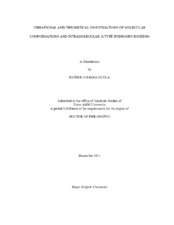| dc.description.abstract | The molecular conformations, potential energy functions and vibrational spectra of several cyclic molecules have been investigated by ab initio and density functional theory calculations and by infrared and Raman spectroscopy. The ab initio computations of 3-cyclopenten-1-ol predict that its lowest energy conformer has a weak pi-type intramolecular hydrogen bonding. The three other conformers lie 301 to 411 cm^-1 higher in energy. The infrared and Raman spectra of this molecule confirm the presence of the four conformers. The energy difference between the two conformers of lowest energy was also determined from the experimental spectroscopic data and was found to be 435 plus/minus 160 cm^-1, in reasonable agreement with the ab initio computations results.
Ab initio calculations for cyclopentane and d1, 1,1-d2, 1,1,2,2,3,3-d6, and d10 isotopomers confirm cyclopentane confirmed that has twist and bent structures and that these differ in energy by less than 10 cm^-1. The bending angle is 41.5 degrees and the twisting angle is 43.2 degrees. A complete vibrational assignment for each of the isotopomers was achieved.
Ab initio calculations were also carried out for methylcyclopropane, cyclopropylsilane, cylopropylgermane, cyclopropylamine, cyclopropanethiol and cyclopropanol. The structure and the potential energy function for internal rotation was calculated for each and compared to available experimental results determined from infrared and Raman spectra. The calculated barriers to internal rotation agree very well with the experimental data.
The structures, relative energies, and frequencies for the lowest energy vibrations of the twisted, bent, and planar forms of cyclohexene and four of its oxygen analogs were calculated and compared to experimental results. The calculated structural data agree very well with that from the microwave work, but the computed barriers are somewhat lower than those based on far-infrared data.
4-Silaspiro-(3,3)-heptane possesses two four-membered rings, each puckered with and angle of 34 degrees. The molecule possesses a two-dimensional ring-puckering potential energy surface with four equivalent minima. The ab initio calculations predict a barrier to planarity of each ring of 582 cm^-1 while the energy of the structure with both rings planar is 1220 cm^-1 higher. The calculated infrared and Raman spectra were compared to those previously published, and the agreement is excellent. | en |


